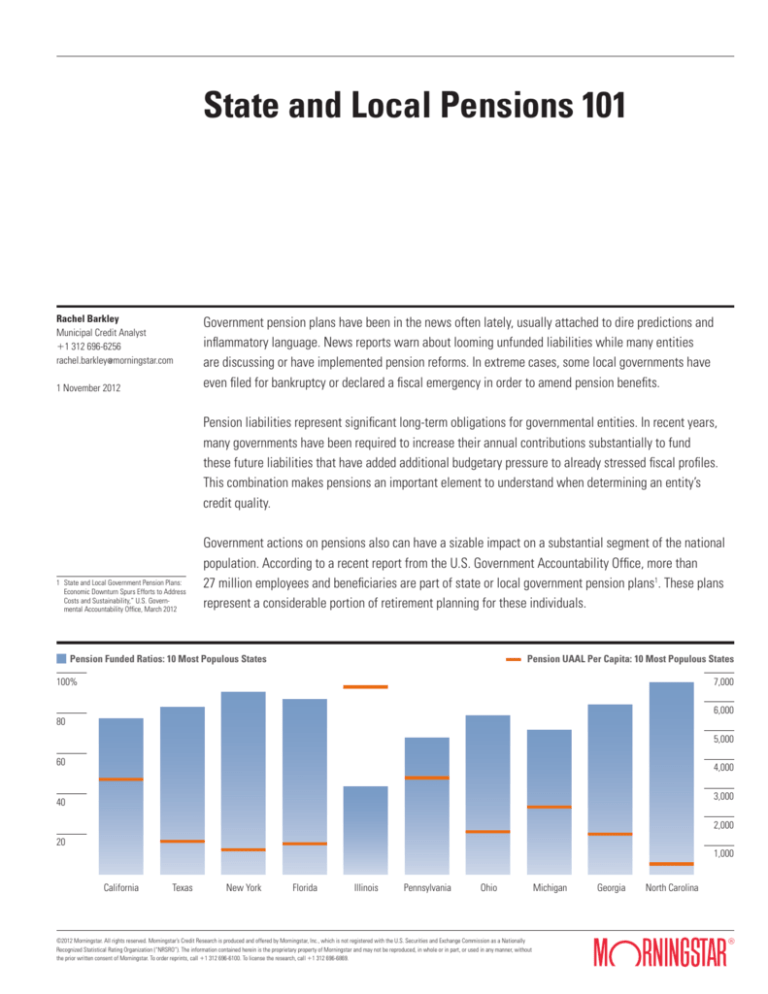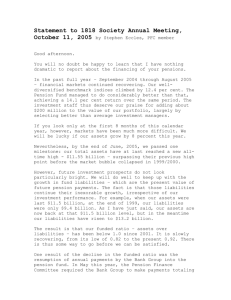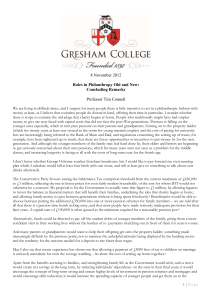
State and Local Pensions 101
Rachel Barkley
Municipal Credit Analyst
11 312 696-6256
rachel.barkley@morningstar.com
1 November 2012
Government pension plans have been in the news often lately, usually attached to dire predictions and
inflammatory language. News reports warn about looming unfunded liabilities while many entities
are discussing or have implemented pension reforms. In extreme cases, some local governments have
even filed for bankruptcy or declared a fiscal emergency in order to amend pension benefits.
Pension liabilities represent significant long-term obligations for governmental entities. In recent years,
many governments have been required to increase their annual contributions substantially to fund
these future liabilities that have added additional budgetary pressure to already stressed fiscal profiles.
This combination makes pensions an important element to understand when determining an entity’s
credit quality.
1
State and Local Government Pension Plans:
Economic Downturn Spurs Efforts to Address
Costs and Sustainability,” U.S. Governmental Accountability Office, March 2012
Government actions on pensions also can have a sizable impact on a substantial segment of the national
population. According to a recent report from the U.S. Government Accountability Office, more than
27 million employees and beneficiaries are part of state or local government pension plans1. These plans
represent a considerable portion of retirement planning for these individuals.
Pension Funded Ratios: 10 Most Populous States
Pension UAAL Per Capita: 10 Most Populous States
100%
7,000
6,000
80
5,000
60
4,000
3,000
40
2,000
20
1,000
California
Texas
New York
Florida
Illinois
Pennsylvania
Ohio
©2012 Morningstar. All rights reserved. Morningstar’s Credit Research is produced and offered by Morningstar, Inc., which is not registered with the U.S. Securities and Exchange Commission as a Nationally
Recognized Statistical Rating Organization (“NRSRO”). The information contained herein is the proprietary property of Morningstar and may not be reproduced, in whole or in part, or used in any manner, without
the prior written consent of Morningstar. To order reprints, call 11 312 696-6100. To license the research, call 11 312 696-6869.
Michigan
Georgia
North Carolina
2
State and Local Pensions 101
Despite the importance of pensions on both the governmental and individual level, they are often poorly
understood. With this in mind, Morningstar aims to shed some light on pensions and their potential
impact on state and local governments.
What are Public Pension Plans?
Pension plans provide post-retirement monetary benefits for eligible retirees. Benefits are determined by
the type of the plan, discussed further below, while actual benefits can vary widely both between
plans and within a single plan based on a number of factors. Plans typically are managed by a board of
trustees that is responsible for investment management.
Why Do Governments Offer Them?
2
Alicia Munnell, et al., “Comparing Compen-
sation: State-Local Versus Private Sector
Workers,” Center for Retirement Research at
Boston College, September 2011
State and local governments offer pension benefits for a variety of reasons. Generally, compensation
tends to be less than in the private sector during the working years of the employee2. Generous pension
benefits, as well as other post-retirement benefits, are used to offset a portion of this wage gap,
allowing governments to remain competitive in attracting a skilled work force. Benefits allow beneficiaries
to achieve a measure of financial security in their post-retirement years. In some cases, government
workers are not eligible for Social Security benefits, making their pension all the more important to ensure
they have sufficient revenue for their retirement years.
Why are State Pension Plans Particularly Important?
State pension plans often have wide-ranging effects. State plans frequently serve as umbrella plans
covering employees for local governments. The majority of these local governments are required to make
annual contributions to the state plans. Plan contributions are influenced by market returns, actuarial
assumptions and methodology as well as the number and type of employees attributable to each
governmental participant. The state often dictates required contributions for plan members, based on
annual legislation, statutory requirements, or actuarial projections. These contributions can place
budgetary stress on participating governments. Additionally, if the state government does not require
adequate annual contributions, the unfunded liability increases, leading to what can be a considerable
financial pressure to the participating governments in future years.
State pension plans that solely cover state employees can also have a notable influence on local
governments within the state. As states provide substantial aid to school districts and other local governments, financial pressure on state governments, including strain stemming from increasing pension
costs, can lead to reductions in intergovernmental aid to local governments.
What Can Be the Impact for Governments?
Morningstar notes that many governments have been able to manage their pension liabilities while
continuing to maintain adequate fiscal solvency. However, state and local governments have been facing
3
State and Local Pensions 101
considerable budgetary pressure for the past few years. Labor-related costs, including pension
payments, continue to account for a significant portion of total government spending. Required pension
payments have escalated in many places as plans have absorbed investment losses associated with
the recession, adding further stress to a government’s fiscal profile. Investment losses have also increased
unfunded pension liabilities, which can create a looming fiscal obstacle that will have to be funded
in future years. Failure to adequately manage pension obligations has led to a decline in overall credit
quality for some entities.
Why Have Government Pensions Been in the News So Often Lately?
3 Terms with an asterisk are defined in
the Glossary of Terms appendix (Page 9).
Governments across the nation have dealt with rising pension costs and liabilities in a variety of manners.
As revenue declined in recent years with the recession, governments have been forced to reduce
spending and take a hard look at any large cost drivers. This has led to many governments trying to implement changes to their pension plans. Changes typically include anything from increasing the employee
contribution rate, adjusting the cost of living formula, or revising the benefit formula. In some cases,
the type of pension plan is changed from a defined benefit, or DB, plan*3 to a defined contribution, or DC,
plan*, or a hybrid plan.
These measures are frequently required to be voted on by the Legislature and are often opposed by
government employees. In some areas, agreement from labor unions is necessary for implementation.
The combination of the impact on the government’s budget coupled with, at times, vocal opposition by
affected employees has led to pensions being in the news more frequently over the past few years.
In very rare cases, unsustainable pension costs have led a few local governments to file for Chapter 9
bankruptcy. These cases have been heavily covered by news organizations, intensifying the focus
on the issue of pensions.
How Does Accounting for Pension Plans Work?
A governmental entity, usually the employer, and often the employee make contributions to the plan that,
combined with investment earnings, are expected to fund future benefits. Contributions are determined
by either an actuary or through legislative and/or statutory guidelines. These contributions are then
invested with the total of contributions and earnings accounting for the plan’s assets. Annual gains or
losses on the value of investments are incorporated into total assets, depending on the actuarial
methodology, discussed in the following section. Contributions and their respective investment earnings
are generally placed in trusts and are irrevocable with assets dedicated to providing pension benefits
to plan members.
Upon retirement, retirees and beneficiaries are entitled to annual payouts, which are determined by plan
type (defined benefit versus defined contribution).
4
State and Local Pensions 101
In order to determine the long-term obligations of the DB plan, the municipality hires an actuary to
conduct a valuation of the plan. This is typically done on an annual basis. The actuary considers a number
of variables and assumptions that cover three major categories: work force, demographics, and
economics. Work force data includes current and anticipated work force levels as well as current and
projected age of employees. Demographic variables incorporate anticipated mortality and disability
rates in addition to projected rate and age at retirement. Economic assumptions involve salary growth
assumptions, the expected rate of return for investments and inflation (cost of living) adjustments
over time. The actuary uses this information to come up with the expected long-term liabilities of the plan
as well as an annual actuarial required contribution*, or ARC, equal to the level of annual funding
necessary for projected assets to meet projected liabilities over time.
Participants of defined contribution plans are entitled to payments based on the actual contributions and
investment income with no obligation by the government to make set payout amounts.
How are Pensions Analyzed From a Credit Perspective?
Morningstar analyzes pension plans based on three main pillars: plan structure, plan management, and
plan funding. The discussion below is based on current pension accounting standards. As detailed
later in the report, new accounting standards will lead to changes in how pensions are analyzed over the
next few years.
Plan Structure
Benefit Type
Public pensions are divided into groups based on whether their benefit provisions are defined benefit,
defined contribution, or hybrid.
Single-employer or Multi-employer Plan
Participants of a plan are either all related to one employer or can be from multiple employers, the latter
of which is often the case with state pension plans.
Types of Multiple-employer Plans
Multiple-employer plans come in two types: cost-sharing multiple employer*, or CSME, plans and
agent multiemployer plans*. CSME plans are the more common of the two types. Participants in CSME
plans have a higher level of risk from other members than in the agent plans.
Tiers
Governments engaging in pension reforms often create a new tier for future and at times current
employees with recently adopted pension legislation applying to the newly created tier.
5
State and Local Pensions 101
Who is Covered, is it Required, and Who is Responsible for Contributions?
For multiple-employer plans it should be noted who is covered in the plan and if it is required for those
entities to participate in the plan. States may require one type of entity (counties, and so on) to participate
but make participation optional for other local forms of government. Additionally, states often
operate plans where they make contributions on behalf of other governments (often school districts for
teacher retirement plans) as well as act as the administrator for plans to which they are not liable
for contributions. Analysts should determine if an entity is required to participate in the current plan, and
which governmental entity is required to make payments. If possible with multiemployer plans, analysts
should try to determine the percent of the total liability for which each government is responsible.
Plan Management
Pension Plan Changes
Any enacted or proposed changes to benefits or contribution levels are analyzed for their impact on the
plan’s overall liability as well any effect on government contributions.
Investment Portfolio
Investment portfolio analysis looks at the diversity and allocation of investments. The portfolio is
examined in terms of historical returns for each asset class as well as for relative risk levels.
Investment Assumptions
The assumed investment return over the life of the plan is examined in terms of how it compares with
actual historical returns, assuming the current asset allocation, as well as how it measures up
against the assumed rate of rate of other plans. A lower assumed rate than actual returns would inflate
the liability while a higher assumed rate would present a plan in artificially positive light.
Plan Funding/Accounting
Liability and Funding Levels
The actuarial value of assets*, or AVA; actuarial accrued liability*, or AAL; unfunded actuarial accrued
liability*, or UAAL, and funded ratio* are the main aspects in analyzing a plan’s financial position.
Definitions and calculations for these data points are included in the Glossary of Terms appendix.
The UAAL is looked at relative to the size of the population and government spending while the funded
ratio allows analysts to compare pension plans effectively without regard for size disparities.
A low relative UAAL and a high funded ratio are considered credit positives while the reverse would be
a credit negative.
Contributions
Contributions to pension plans are important for a variety of reasons. When analyzing the strength
of the pension plan, analysts look to see if current contribution levels, coupled with investment earnings,
6
4
State and Local Pensions 101
Alicia Munnell et al., “Why Don’t Some
States and Localities Pay Their Required
Pension Contributions?” Center for
Retirement Research at Boston College,
May 2008
are expected to fund the plan to a level that will be able to meet its pension obligations. Under
current accounting standards, the annual required contribution, or ARC*, is a good basis for this analysis.
In short, paying the ARC annually is expected to produce a fully funded pension plan. Analysts monitor
if the entity is fully funding the ARC annually. How contribution levels are determined is also important.
Depending on the entity, contribution levels can be set by the actuary (the ARC) or by legislative or
statutory regulations. Several states have historically prohibited local entities as well as themselves from
making contributions equal to the full ARC through legal constraints4. Any gap in payment between the
ARC and actual payments results in growth in the plans’ unfunded liability.
Contributions are also examined for their impact on the entity’s budget. Government contributions are
looked at annually as a percentage of total spending. The higher the percentage of total spending
accounted for by pension payments, the less overall financial flexibility an entity has. Additionally, any
sizable changes in the growth rate of contributions are also important as it indicates an increase
in total pension liabilities as well as further potential budgetary pressure if rapid escalation in contribution levels continues. A final detail to consider is if employees are responsible for any portion of
total contribution levels. A combination of employer and employee contributions reduces government
liabilities and contributions.
Asset Valuation Method*
The actuarial value of the plan recognizes gains and losses in the market value of plan assets dependent
on the asset valuation method. These returns are used to determine the AVA and compared with prior
assumptions to form the AAL, UAAL, and actuarial-required funding for the upcoming year. There are two
types of methods: market value* and smoothing*, with smoothing being the more common of the two.
In the long run, actual assets and liabilities for a plan remain unchanged no matter which method is used.
However, the choice of the asset valuation method and length of smoothing period can have a major
impact on how pensions are presented from year to year. A plan would appear stronger during a time of
market growth using the market value method compared with the smoothing method, and weaker
during a time of investment losses. Analysts should note which method is used as well as the length of
the smoothing period, if applicable. For plans using the smoothing method, it should be noted if any
large increases or decreases are expected to be incorporated over the next few years.
Actuarial Cost Method*
Analysts can use this allocation to identify how much of the total projected liability is already accrued and
what portion is attributable to future work. There are currently six acceptable methods: entry age
normal, frozen entry age, attained age, frozen attained age, unit credit, and aggregate. The total liability
of a plan is not changed by the chosen actuarial cost method. However, similar to the actuarial
valuation method, the chosen actuarial cost method can have an impact on how well-funded a plan can
7
State and Local Pensions 101
appear. The entry age normal method* is the most common method and, with the implementation
of the new GASB regulations discussed in the report below, will soon be the only allowable method.
How Does This Relate to Credit Quality?
Pension obligations are included under the debt and long-term liabilities analysis of a credit, which
accounts for one of Morningstar’s four pillars that drive the assessment for all sectors under U.S. public
finance. Morningstar evaluates the magnitude of the liability and assesses the entity’s ability to
meet these obligations over the long term along with the accompanying projected impact on future
financial flexibility. A large unfunded pension liability and/or general budgetary pressure stemming from
pension payments can be credit negatives that can put downward pressure on credit quality.
Morningstar, however, notes that credit quality is determined by the overall picture of the entity, with
pension analysis forming one portion of the overarching evaluation.
What Will Change with the New GASB Legislation?
The Governmental Accounting Standards Board, or GASB, which establishes government accounting
standards, approved new accounting and reporting standards for state and local government pension
plans in June 2012 under GASB Statements Number 67 and 68 with the goal of improving the accounting
and financial reporting for affected plans. GASB standards are nonbinding but compliance is required
for governments to receive a clean audit. The new pension standards become effective for state and local
pension plans in fiscal years beginning after June 15, 2013 and for employers in fiscal years beginning
after June 15, 2014. While it will be a few years until all applicable governments fully incorporate these
standards, some areas will likely move toward early adoption and compliance.
Overall, the new standards aim to focus pension disclosure on liabilities, as opposed to the ARC. For
defined benefit plans, disclosure of the ARC will no longer be required. Instead, annual change in
the net pension liability*, or NPL, will serve as the primary pension expense reported. Analysts will need
to judge movement of the NPL to determine if an entity is making adequate contributions to the plan.
DB plans will be required to report an NPL on their balance sheets. This will, in many cases, cause a
drastic change in the balance sheet presentation, particularly in terms of total liabilities. This number is
expected to be relatively volatile as asset smoothing will not be allowed for accounting purposes.
The NPL will be measured at market value with annual changes immediately recognized. Despite its
expected volatility, the implementation of the NPL will allow for investors and constituents to gain a
clearer picture of actual projected liabilities as this data is currently only disclosed in the financial notes
section of a government’s audit. Cost-sharing, multiemployer plans will record a liability and expense
equal to their proportionate share of the total plan liability and expenses, allowing analysts to accurately
incorporate pension liabilities into analysis of credits that participate in a CSME plan.
8
State and Local Pensions 101
Additionally, some changes are being made to allowable accounting methods. As mentioned above,
smoothing will no longer be allowable for accounting measurements but it will still be allowed
for funding purposes. Actuarial cost methods will be limited solely to the entry age normal method.
Additionally, liabilities will be required to be allocated as a level percentage of payroll and will no longer
be able to be allocated as a level dollar amount. The discount rate of liabilities will change for
accounting purposes, but will remain unchanged for funding calculations. For accounting purposes, the
allowable assumed discount rate will depend on whether the plan’s net position is projected to be
sufficient to pay benefits of current employees and retirees. If that condition is met, the regular discount
rate is able to be used. An index rate on tax-exempt 20-year AA or higher rated municipal bonds
will be used to the extent projected assets are not anticipated to meet projected liabilities. Overall, these
accounting changes will cause a disconnect between pension funding and accounting while leading to
greater levels of volatility for pension accounting measures.
5
Munnell, Alicia, et al., “How Would GASB
Proposals Affect State and Local Pension
Reporting?” Center for Retirement Research
at Boston College, November 2011
In aggregate, the funded level of pension plans is expected to decrease because of the accounting
changes. A recent report by the Center for Retirement Research at Boston College indicated the aggregate-funded level for 126 large pension plans it sampled would decline from 76% based on fiscal
2010 levels to a low 57%5. This decline in funding, coupled with the emphasis on the NPL, will likely
increase the level of debate regarding pension benefits and their impact on governments. What are Some Red Flags I Should Look for to Determine a Stressed Pension Plan?
Despite the recent increase in news coverage of state and local pension plans, the majority of pension
plans currently remain adequately managed. However, several pension systems are experiencing
considerable pressure. These pressures typically build over time and can often be identified years before
substantial stress is placed on the applicable government. Red flags that indicate the solvency of a
pension plan is deteriorating include a substantial unfunded pension liability, a low and/or declining
funded ratio, annual contributions less than the ARC, rapid increases in annual contributions, and pension
costs accounting for a significant portion of general government spending. K
9
State and Local Pensions 101
Glossary
Actuarial Accrued Liability (AAL)
The present value of future benefits earned by employees
to date.
Actuarial Cost Method
The actuarial cost method is the process used by the
actuary to allocate the projected liabilities of the plan to
prior years (the actuarial accrued liability), the current
year (the normal cost), and future years.
Actuarial Value of Assets (AVA)
The actuarial value of the plan’s assets. This amount
incorporates investment gains and losses dependent upon
the asset valuation method.
payment, adjusted annually for cost of living, or adjusted
occasionally for cost of living increases as seen fit
by the overseeing party. The government is responsible for
funding this liability no matter what return it achieves
on its investments.
Defined Contribution Plan (DC)
Defined contribution plans are similar to 401(k)s found in
the private sector. The government is obligated to
contribute a certain amount annually until retirement
while the actual benefit is subject to market
returns. The government has no liability to make up for
investment losses.
Entry Age Normal Actuarial Cost Method
Agent Multiple-Employer Plan
In agent multiemployer plans, assets are pooled but
legally restricted to pay pension obligations of their
specific employer.
Entry age normal allocates the cost of benefits from the
time an employee is hired (the entry age) to the date
of expected retirement either as a level dollar amount or as
a percentage of payroll.
Annual Required Contribution (ARC)
Funded Ratio
The ARC is determined by the actuary during the valuation
of the plan and equals the amount that would need
to be paid during the current fiscal year to fund benefits
earned in that year (the normal cost) plus a portion of any
unfunded liability from past years.
The percentage of the AAL that is currently funded through
the AVA. This is calculated by dividing AVA by the UAAL.
Asset Valuation Method
The actuarial value of the plan recognizes gains and losses
in the market value of plan assets dependent on the asset
valuation method.
Cost Sharing Multiple Employer Plan (CSME)
In CSME plans, the participating employers pool their
obligations and assets. Assets of the plan can be used to
pay pension obligations of any participating employer.
Market Value Method of Asset Valuation
Under the market value method, plans recognize the
full amount of actual gains or losses at the end of each
fiscal year.
Net Pension Liability (NPL)
The NPL is the total pension liability (actuarially determined present value of future benefits that are due to work
already completed by plan participants) less the plan
net position (plan assets set aside in a trust or restricted
for benefit payments).
Smoothing Method of Asset Valuation
Defined Benefit Plan (DB)
For defined benefit plans, pension payments operate as an
annuity with each employee entitled to a specific
annual payment based on a benefit formula. These
formulas generally incorporate years of service, salary, and
a multiplier variable. Specific benefit formulas vary
between plans and often within plans dependent on an
employee’s start date and/or employee classification
(public safety, general, management, and so on). Defined
benefit payments can be constant for the life of the
Smoothing incorporates any deviation between expected
returns and actual results over a period of years.
Assuming a five-year smoothing period, which is common,
20% of any variation between expected and actual
results for a given year would be incorporated into the AVA
for each of the next five years.
Unfunded Actuarial Accrued Liability
The difference between the AVA and the AAL.






